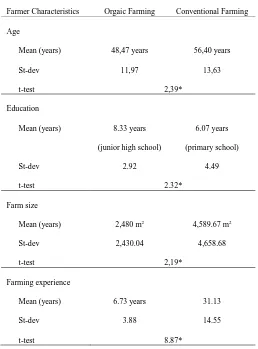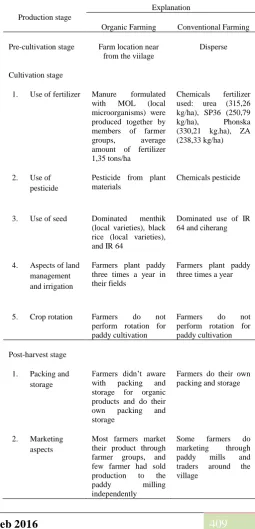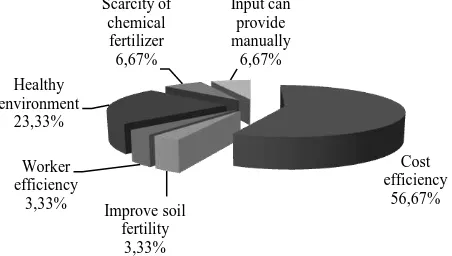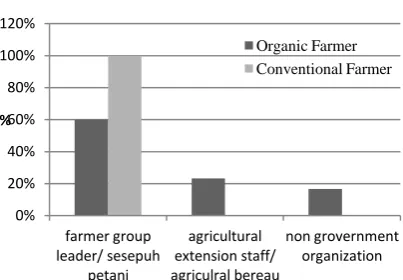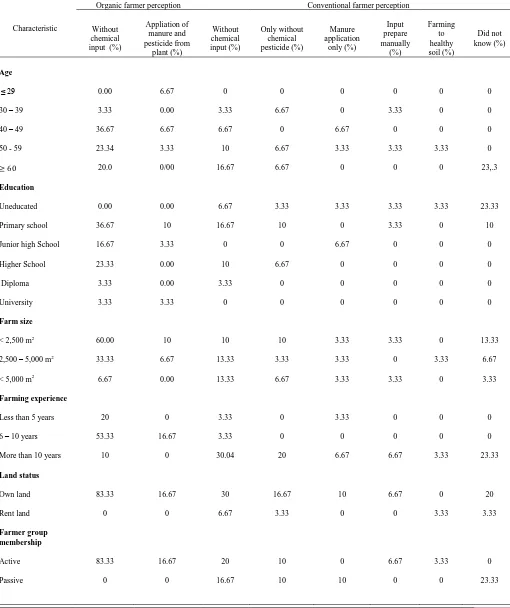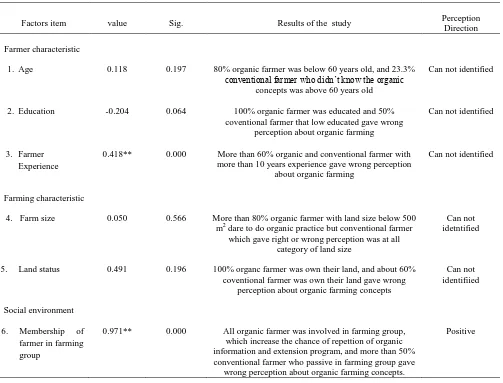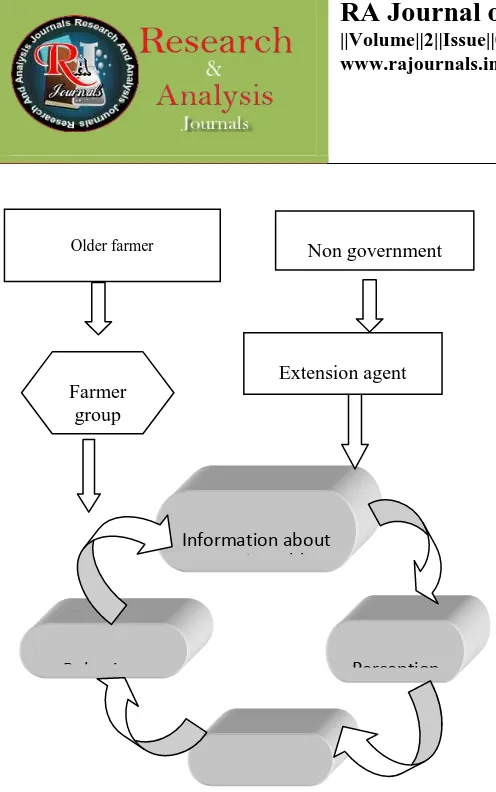Tinjung Mary Prihtanti
1, RAJAR Volume 2 Issue 02 F eb 2016
407
Farmer group as social determinant of farmer’s perceptions on
organic farming concepts and practice
Tinjung Mary Prihtanti
11
Agribussines Department, Faculty of Agriculture and Bussines, Satya Wacana Christian University
Diponegoro street 52-60 Salatiga 50711
Email: [email protected]
I N T RODUC TI ON
A strategic option to accelerate development realization of the agribusiness competitive, sustainable and environmentally farming in order to improve the welfare of the people, especially farmers, is organic farming. Organic farming is recognized as an important system of agriculture and food production, that is environmentally sustainable and can generate several positive impacts to rural society. The World Board of the International Federation of Organic Agriculture Movements (IFOAM) approved the Organic agriculture is a production system that sustains the health of soils, ecosystems and people. It relies on ecological processes, biodiversity and cycles adapted to local conditions, rather than the use of inputs with adverse effects. Organic agriculture combines tradition, innovation and science to benefit the shared environment and promote fair
relationships and good quality of life for all involved’.
Organic farming in Indonesia, still rare although its program in Indonesia has been initiated since "Go-Organic 2010" program launched by the Ministry of Agriculture in 2000. Based on SOEL survey in Giovannucci (2005), mentioned that the organic farming area in Indonesia was around 40,000 hectares (0.09 per cent to total area or equal to 0.33 per cent of total paddy area). By implementing organic farming practices, Indonesia farmers are expected to reduce their dependence on chemical fertilizers as well as preserving environmental sustainability (Hidayat and Lesmana, 2011).
Until recently, farmers’ knowledge of organic farming has been ignored by researchers because decreasing
dissemination. Scialabba’s and Hattam’s (2002) review of
developing countries efforts in organic agriculture points out the weakness of institutional support for existing knowledge and exchane in organic agriculture. Singh and George (2012) conclude that even farmers are aware of some of the basic facts of farming but they were not aware of all aspects related to certification and standards given by different agencies Triyuyun research results (2011) showed that the perception of stakeholders in Karanganyar towards organic farming systems and the attributes of the technology is low, awareness of stakeholders on the environmental and economic benefits of organic farming are not always followed by changes in the behavior of farmers in adopting organic farming. Tarleton and Ramsey (2008) suggested that perception will gave influence on adaptive capacity, in case climate risk perception.
Several study has found that perception of farmer influenced by internal factors such as farmer characteristic. Sagay et al (2014) argued that internal factors was the main focus in
improving farmers’ perception in developing irrigation
areas, which the main factor of perception formation was internal factors, followed by external factors. As Bagheri et al (2008) argued that there was significant relationship between perception towards sustainable agricultural technologies and variables consisting of age, educational level, educational discipline, years of experience in
agriculture, farmer’s cultivated area, sharecropping, diversity of farmer’s rice varieties, out of farm income,
contact with information sources/channels and extension participation. On the other side, Kallas et al (2009) identify the policy changes that have been more relevant in motivating adoption of organic practices. The result of Asadi et al (2009) showed that the first and the major effective factor in agricultural organic product diffusion is institutional factors.
Tinjung Mary Prihtanti
1, RAJAR Volume 2 Issue 02 F eb 2016
408
This paper intends to contibute to the existing literature by
providing an empirical analysis of farmers’ awareness and
their knowledge about organic farming through perceptions and practice analysis, and compare the awareness of organic paddy farmer to conventional farmers.
MET HOD S
This study was conducted in Pereng and Gentungan viilage, Mojogedang sub-district, Karanganyar regency. In Mojogedang Sub-district, there is a small group of farmers practicing organic paddy farming. The sub-district of Mojogedang height is about 380 m above sea level, and lots of precipitation 2590 mm/year and soil type at this area is litosol and brown mediteran.
Irrigation is available throughout the year led farmers can cultivate three times during the year. People in Pereng who cultivate organic paddy embodied in a farmer groups, Rukun Makaryo, while organic paddy farmers in the village of Gentungan incorporated in the Tani Mulyo. Results of observation and learn from earlier studies tend a reduction in the number of organic paddy farmers.
The results presented in this paper are based on qualitative and quantitative methods of primary data collection and inquiry. In order to study the differences of two paddy farming systems, total of 60 farmers whom 30 farmers are dealing with organic farming and other 30 farmers from conventional farming were subjected for the interview in this study. Furthermore, qualitative and quantitative methods such as semi-structured and in-depth interviews, identification of key-informants, focus group discussion (FGD) and field visits were used to fulfill the necessary data needed in this study. Descriptive statistics and crosstab
analysis with Somers’d procedure were used to analyzed data using the computer software SPSS. Somers’d measure
the relationship between two variables ordinal scale that can be formed into a contingency table. The advantage of this
formula can determine the direction a relationship. Somers’d
calculated by the following equation:
Somers’D =
Note:
Ns : concordant
Nd : discordant
Ty : column pair
RESULT S A N D DI SC US SI ON
Farmer Characteristics
Table 1. Paddy Farmer Characteristics
Farmer Characteristics Orgaic Farming Conventional Farming
Age
Mean (years) 48,47 years 56,40 years
St-dev 11,97 13,63
t-test 2,39*
Education
Mean (years) 8.33 years
(junior high school)
6.07 years
(primary school)
St-dev 2.92 4.49
t-test 2.32*
Farm size
Mean (years) 2,480 m2 4,589.67 m2
St-dev 2,430.04 4,658.68
t-test 2,19*
Farming experience
Mean (years) 6.73 years 31.13
St-dev 3.88 14.55
t-test 8.87*
Note : * significant at 5% level, respectively
As shown in Table 1, the average age of organic paddy farmers are relatively younger than the conventional paddy farmers, on the other side, education of organic paddy farmers relatively higher than conventional paddy farmer, and statistically significantly different. Education and age were affecting farmer knowledge and acceptance of the new technologies. A study by Jamison and Lau (1982) mentioned that the success of Thailand, Korea and Malaysia in increasing the productivity of their agriculture sector was by education.
Tinjung Mary Prihtanti
1, RAJAR Volume 2 Issue 02 F eb 2016
409
Farmer Perception and Practice: Organic vs Conventional Farming
Farmer perception is part of that personal dimension that makes farmer see situations differently as well as shapes their attitude in terms of their work environment. Perception is important for understanding farmer differences because how farmer perceived a situation determines how farmer
behave. Farmer’s behavior is based on their perception of
what reality is, not on reality itself. Result of this study found that there was different perceptions and knowledge among farmers towards organic concepts, as showed at Table 2.
Majority of the organic farmer-respondent define organic agriculture as the absence of chemicals used in farming. Most farmers (83.3%) declared organic farming is farming without chemicals fertilizer and pesticide. However, not all organic paddy farmers had same perception, which 16.67% of farmers were gave practical answer that organic farming is the use of manure and pesticide used raw material from plants. On the other side, about 30% of conventional paddy farmers assume that organic farming is farming without chemical inputs, both fertilizers and pesticides, but 20% farmers said that organic farming is only without chemical pesticides and still allowed to use chemical fertilizers in low doses.
Table 2. Paddy Farmer Perception on Organic Farming Concepts
No. Perception Organic
Farmer
Conventional Farmer
1. Without chemical fertilizer and pesticide used
83.3% 30%
2. Application of manure and pesticide from plant to increase farming production
16.7% 6.7%
3. Without chemical pesticide used
Source: primary data analysis (2015)
What was interesting that as many as 23.33% of conventional paddy farmers answered do not know about organic farming. This result proved that conventional farmer did not familiar with organic concepts, although quite a lot of conventional farmers understand that the organic farming is absence of chemical inputs. Conventional farmers assume that organic farming requires fertilizers and pesticides that are difficult to make.
The survey has shown that organic farmers perception about organic farming was not fully in accordance with the appropriate standards of organic farming as listed on the ISO 6729: 2013, which refers to the IFOAM Basic Standards for organic production and processing 2005 on organic food system establishes a system of organic food production, includes provisions on the production, preparation, marketing, labeling of products.
Table 3 depicts the respondents’ practices toward paddy
farming conducted at study sites.
Table 3. Differences between Organic and Conventional Paddy Farming Practice
Production stage
Explanation
Organic Farming Conventional Farming
Pre-cultivation stage Farm location near from the viilage
Disperse
Cultivation stage
1. Use of fertilizer Manure formulated with MOL (local microorganisms) were produced together by members of farmer groups, average amount of fertilizer 1,35 tons/ha
Pesticide from plant materials
Chemicals pesticide
3. Use of seed Dominated menthik (local varieties), black rice (local varieties), and IR 64 three times a year
5. Crop rotation Farmers do not perform rotation for paddy cultivation
Tinjung Mary Prihtanti
1, RAJAR Volume 2 Issue 02 F eb 2016
410
Source: primary data analysis (2015)
This research found that some organic paddy farmers respondents apply local seed and did not aware with crop rotation aspect and management of irrigation; few of organic farmer did not aware in post-harvest treatment and marketing their farm products. This results is similar with Pindozo et al (2014) which revealed that paddy farmers have only low to medium level of awareness on organic farming activties and markets for organic products.
Farmer Motivation
This study found that organic paddy farmers motivation adopted organic farming practices, primarily because of low cost of production under organic system (56.67% of farmers). The next biggest reason why farmers want to adopt organic farming is health concern factors, farmers feels responsible for the environment, land, and human health in the long term (23.33% of farmers).
Figure 1. Farmers’ Motivation in Organic Farming
Source: primary data analysis (2015)
Organic farmer respondent in this study were knowledgeable in producing in their own input. Since organic farming encourages the use of indigenous materials, lower costs are incurred. Farmers are encouraged to produce their own inputs using materials that can be easily found from their farm surroundings, such as manure. This study found only 17% organic farmers respondent didn’t have livestock.
Conventional paddy farmers motivation did not adopt organic farming because of yields uncertainty (46.67%), complicated production system (20%), did not familiar to cultivate organic farming (10%), conventional cultivation has been hereditary (10%), did not know how to sale the organic product to reach higher price (6.67%), as well as long growth period of plants and the productivity of organic farming was not different with conventional farming (respectively 3.33%).
The distribution of the conventional farmers reasons didn’t
adopt organic systems in Figure 2.
Figure 2. Conventional Farmer Reason Didn’t Adopt
Organic Farming
Source: primary data analysis (2015)
These study results are similar to several studies, Prompathansombat et al (2011) concluded that important factors on decision of adoption of organic farming that were positively significant included farm-gate paddy and attitude to conventional production problems, andalso water accessibility. Schneeberger et al (2002) revealed that Austrian farmers did not adopt organic practices due to fear of decreased income and marketing problems. Niemeyer and Lombard (2003) revealed that in South Africa, the lack of marketing opportunities, no premium paddys, and the lack of subsidies had kept the farmers from adopting organic practices. Kennvidy (2011) revealed that farmers shifted to organic farming in order to reduce the expenses on synthetic fertilizers, to avoid the negative effects of synthetic fertilizers to health, to utilize the available resources in the neighborhood, to conserve the environment as well as soil and water quality and to acquire the beneficial paddys on organic products
Factors Affecring Perception on Organic Farming Concepts
Tinjung Mary Prihtanti
1, RAJAR Volume 2 Issue 02 F eb 2016
411
Figure 3. Perception Process
(Source: Kings and Ilbery, 2012)
A major theoretical issue on which psychologists are divided is the extent to which perception relies directly on the information present in the stimulus. Some argue that perceptual processes are not direct, but depend on the perceiver's expectations and previous knowledge as well as the information available in the stimulus itself. Stimulus from the environment in the form of information about organic farming. Information about organic rice farming is very important for the farmers perceptions and to change their practice, enhance knowledge on farming and production.
This study found that farmers’ major sources of knowledge on organic farming was farmer group leader. Approximately 60% of organic farmer respondents replied the farmer group chairman Pereng elder farmer in the village is the first and primary resources of organic concept and practice. This result different with Pornpratansombat et al (2011) mentioned approximately 60 percent of organic rice farmers have got information from extension agents (government and NGOs agents), in form of group meeting. In addition, 18 percent of organic farms have got information from their neighbouring farmers (relatives and friends), while mass media (TV and radio) takes about 14 percent. Mahamud (2005) mentioned significant factors affecting the acceptance of organic rice production as level of organic agriculture knowledge and extension measures received from involved agencies.
Figure 4. Source of Information of Organic Farming
(Source: primary data analysis (2015))
The emergence of organic farmers in the district Mojogedang greatly influenced by the role of an elder farmer who pioneered and disseminate information about the farm without chemicals. Mbah Paimanhadi is the chairman of farmer groups in the village Pereng Rukun Makaryo, which seeks to transmit the understanding and practice of organic on group members. His efforts led to their farmer groups receive recognition from an organic certification organization. Echoes of organic farming village Pereng even spread to other villages, namely Gentungan Village, District Mojogedang, and farmer groups Tani Mulyo which also received organic certification in 2014. Government agencies and non-governmental organizations have a role in assisting the organic farmer groups, the standards and requirements untu certified organic products. However, the farmers themselves play a key role since the farmer group leader gained knowledge through his own resources and initiatives.
Stimuli from the environment in the form of information heard from several sources of information, supported by evidence to be viewed directly from the experience of the chairman of the group of farmers who have practiced organic rice farming, encourage positive perceptions that organic farmers adopting organic farming; but on the other hand the experienceon organic farming did not necessarily encourage a positive perception of conventional paddy farmer, which is seen from still a number of conventional farmer who think organic farming is impractical and cumbersome in organic fertilizers preparation and pesticides.
There are three factors influenced the perception, first perceptor variable, the character of the object of perception, and situation factors. According Kallas, et al (2009), relevant factors that can influence the decision to convert from conventional to organic farming include: farmer characteristics, farm structure, farm management, exogenous factors, attitudes and opinions. Bagheri et al (2008) found that easy access to chemical fertilizer made negative perception about the application of manures, while educational level had a strong power in predicting of
farmers’perception followed by extension participation and
0% 20% 40% 60% 80% 100% 120%
farmer group leader/ sesepuh
petani
agricultural extension staff/ agriculral bereau
non grovernment organization
%
Tinjung Mary Prihtanti
1, RAJAR Volume 2 Issue 02 F eb 2016
412
contact with experts which are all related to the knowledge of the respondents.
Table 4. Characteristics and Perception of Paddy Farmer
Characteristic
Organic farmer perception Conventional farmer perception
Without chemical input (%)
Appliation of manure and pesticide from
plant (%)
Without chemical input (%)
Only without chemical pesticide (%)
Manure application
only (%)
Input prepare manually
(%)
Farming to healthy soil (%)
Did not know (%)
Age
≤ 29 0.00 6.67 0 0 0 0 0 0
30 – 39 3.33 0.00 3.33 6.67 0 3.33 0 0
40 – 49 36.67 6.67 6.67 0 6.67 0 0 0
50 - 59 23.34 3.33 10 6.67 3.33 3.33 3.33 0
20.0 0/00 16.67 6.67 0 0 0 23,.3
Education
Uneducated 0.00 0.00 6.67 3.33 3.33 3.33 3.33 23.33
Primary school 36.67 10 16.67 10 0 3.33 0 10
Junior high School 16.67 3.33 0 0 6.67 0 0 0
Higher School 23.33 0.00 10 6.67 0 0 0 0
Diploma 3.33 0.00 3.33 0 0 0 0 0
University 3.33 3.33 0 0 0 0 0 0
Farm size
< 2,500 m2 60.00 10 10 10 3.33 3.33 0 13.33
2,500 – 5,000 m2 33.33 6.67 13.33 3.33 3.33 0 3.33 6.67
< 5,000 m2 6.67 0.00 13.33 6.67 3.33 3.33 0 3.33
Farming experience
Less than 5 years 20 0 3.33 0 3.33 0 0 0
6 – 10 years 53.33 16.67 3.33 0 0 0 0 0
More than 10 years 10 0 30.04 20 6.67 6.67 3.33 23.33
Land status
Own land 83.33 16.67 30 16.67 10 6.67 0 20
Rent land 0 0 6.67 3.33 0 0 3.33 3.33
Farmer group membership
Active 83.33 16.67 20 10 0 6.67 3.33 0
Tinjung Mary Prihtanti
1, RAJAR Volume 2 Issue 02 F eb 2016
413
Source: primary data analysis (2015)
Table 5 outlines the relationship between perception and conditions of farmers using multiple regression analysis.
Table 5. Factors Affecting the farmer Perception on organic farming
Factors item value Sig. Results of the study Perception
Direction
Farmer characteristic
1. Age 0.118 0.197 80% organic farmer was below 60 years old, and 23.3%
conventional farmer who didn’t know the organic concepts was above 60 years old
Can not identified
2. Education -0.204 0.064 100% organic farmer was educated and 50%
coventional farmer that low educated gave wrong perception about organic farming
Can not identified
3. Farmer Experience
0.418** 0.000 More than 60% organic and conventional farmer with
more than 10 years experience gave wrong perception about organic farming
Can not identified
Farming characteristic
4. Farm size 0.050 0.566 More than 80% organic farmer with land size below 500
m2 dare to do organic practice but conventional farmer which gave right or wrong perception was at all
category of land size
Can not idetntified
5. Land status 0.491 0.196 100% organc farmer was own their land, and about 60%
coventional farmer was own their land gave wrong perception about organic farming concepts
Can not identifiied
Social environment
6. Membership of
farmer in farming group
0.971** 0.000 All organic farmer was involved in farming group,
which increase the chance of repettion of organic information and extension program, and more than 50% conventional farmer who passive in farming group gave
wrong perception about organic farming concepts.
Positive
Source: primary data analysis (2015)
Note: ** are statistically significant
Table 5 depicts that there was significant associatiom between dependent variable, perception, and independent variables, farming experience and membership in farming group.
Tinjung Mary Prihtanti
1, RAJAR Volume 2 Issue 02 F eb 2016
414
Figure 5. Farmer Perception Process on Organic Farming
At Mojogedang district, Karanganyar Regency
(Source: primary data analysis (2015)
Result of this study was similar with Herath and Wijekoon (2013), that participatory extension programs and better extension approaches such as farmer field schools could be
recommended to change growers’ attitude, knowledge and
skills towards organic farming. It can be conclude that paddy farmers who can access more information through their participation in farming group have more accurate perception of organic paddy farming. Darr (2008) argued that innovations tend to disseminate more effectively in farmer groups vis-à-vis non-group networks, and the groups tend to be more effective when addressed by extension agents. Nuryanti and Swastika (2011) conclude that the roles
of farmers’ group are not only as the means of distributing
government extension services, but also as the agent for new technology adoption.Hariadi and Widhiningsih (2015), farmer group role (as a unit of study, cooperation, and production) gives positive and significant effect towards innovation adoption
C ON C LUSI ON S
1. The result of the study showed organic paddy farmers have different characteristics with conventonal paddy
farmers, where organic farmers relatively younger age, more educated, but more narrow area of land tenure. 2. The survey shows an understanding of organic farmers
and the practice though not fully in accordance with the appropriate standards of organic farming and there are 23,3% conventional farmers who do not know about organic farming accurately.
3. Farming experience and membership in farming group were associate with the farmer perception of organic farming concepts.
4. Farmers’ major sources of knowledge on organic farming is farmer elder who was also farming group leader. Easier access to information sources, the presence of extension staff and other institution concerns in organic farming also motivate higher adoption rates.
It takes effort more intensive dissemination of information about organic farming, either through extension program and direct demonstrations, or through mass media, newspaper or electronic media. Government and related institution can help farmers to restore the use of traditional or local seed varieties.
A C KN OWLEDG MEN T
Deepest gratitude for the help and support is extended to Mrs. Maria who in one way have contributed in making this study possible.
REFEREN C ES
[1] Asadi, Ali; Morteza Akbari, Aboulghasem Sharifzadeh, and seyyed Mahmoud Hashemi. 2009. Analysis of farctors affecting Agricultural Organic Products Diffusion among Consumers: Perception of Extension Workers. World Applied Sciences Journal 6 (3): 331-338.
[2] Bagheri, A., H. Shabanali Fami, A. Rezvanfar, A. Asadi and S. Yazdani. 2008. Perceptions of Paddy Farmers towards Sustainable Agricultural Technologies: Case of Haraz Catchments Area in Mazandaran province of Iran. American Journal of Applied Sciences 5 (10): 1384-1391, 2008
[3] Darr, Dietrich. 2008. Effective even when neglected: Farmer groups and the diffusion of agroforetry innovation in rural communities of eastern Africa. Dissertation. Technische Universität Dresden, Institute of International Forestry and Forest Products.
Farmer group Older farmer
Information about organic paddy
farming
Behaviour
Decision
Non government
Extension agent
Tinjung Mary Prihtanti
1, RAJAR Volume 2 Issue 02 F eb 2016
415
[4] Giovannucci, Daniele. 2005. Evaluation of Organic Agriculture and Poverty Reduction in Asia.IFAD. Rome.
[5] Hariadi, Sunarru Samsi, and Diah Fitria Widhiningsih. 2015. Farmer Group Role on Adoption of Local Wisdom Innovationto support Food self-Sufficiency. International Journal of Humanities and Social Science Invention. Vol 4 Issue 10 October 2015: 51-57.
[6] Hamka. 2002. Eduaction Psycology. Jakarta: Rineko Cipta.
[7] Herarth, Chaminda S. And Rusitha Wijekoon. 2013. Study attitudes and Perceptions of Organic and Non-Organic Cococnut Growers towards Non-Organic Coconut Farming. IDESIA volumen 31.no 2. Mayo-Agosto 2013. http://www.scielo.cl/pdf/idesia/v31n2/art02.pdf. retrieved 8 January 2016.
[8] Hidayat, AS. and T. Lesmana. 2011. The development
of rice organic farming in Indonesia’, RIEBS 2 (1), 1-14.
[9] Jamison and Lau. 1982. Farmer Education and Farm Efficiency, Baltimore: The Johns Hopkins University Press.
[10]Kallas, Zein, Teresa Serra, and José M. Gil. 2009.
Farmer’s objectives as determinant factors of organic
farming adoption. 113th EAAE Seminar “A resilient European food industry and food chain in a challenging
world”, Chania, Crete, Greece.
[11]Kennvidy SA. 2011. Organic Paddy Farming Systems in Camodia: Socio-Economic Impact of Smallholder Systems in Takeo Province. IJERD International Journal of Environmental and Rural Development 2011 (2-1): 115-119.
[12]Kings, David, and Brian Ilberry. 2012. Farmers’ Attitudes towards Organic and Conventional Agriculture: A Behavioural Perpective. Organic Food and Agriculture-New Trends and Deveopments in The Social Sciences. InTech. Croatia.
[13]Mahamud, R. 2005. Innovation in agricultural resource management for organic agriculture: case study of organic rice farmers group, Amphoe Kudchum, Changwat Yasothon. Thesis, Kasetsart University, Bangkok
[14]Niemeyer, K. and Lombard J. 2003. Identifying problems and potential of the conversion to organic farming in South Africa. The 41st Annual Conference of the Agricultural Economic Association of South Africa (AEASA). Pretoria, October 2–3, 2003.
Retrieved http://ageconsearch. umn.edu/ bitstream/19082/1/cp03ni01.pdf.
[15]Nuryanti, Sri, and Dewa KS Swastika. 2011. Roles of
farmers’ group in agricultural technology adoption.
Agroekonomi Research Forum Volume 29:2 Desember 2011: 115-128.
[16]Piadozo, MES. F. Lantican. IM Pabuayon. AR Quicoy.
AM Suyat. PKB Maghirang. 2014. Paddy Farmers’
Concept and Awareness of Organic Agriculture: Implications for Sustainability of Philippine Organic Agriculture Program. Journal ISSAAS Vo. 20. No. @:142-156
[17]Pompratansombat P., Bauer B. Boland H. 2011. Tha Adoption of Organic Paddy Farming in Northeastern Thailand. Journal of Organic Systems 6 (3).
[18]Sagay, Benny AB. Z. Kusuma, K. Hidayat, and J. Tatuh. 2014. The Influences of Internal Factors on
Farmers’ Perception and Participation in Bolaang Mongodow Regency. Journal of Research in Environmental and Earth Science. Vol 1 – Issue 2 pp 08-12. http://www.questjournals.org/jrees/ papers/vol1-issue2/B120812.pdf. Retrieved 8 January 2015.
[19]Schneeberger. WI. Darnhofer and M. Eder. 2002. Barriers to Adoption of Organic Farming by Cash-Crop Producers in Austria. American Journal. Alternative Agriculture 17(01): 24-51.
[20]Sciablabba, N. And C. Hattam. 2002. Organic Agriculture, Environment and Food Security, Environment and Natural Resources Series No. 4. Food and Agriculture Organization. Rome.
[21]Singh, S. And RI. George. 2012. Organic Farming Awareness and Beliefs of Farmers in Uttarakhand, India. Journal Human Ecology. 37(2): 139-149.
[22]Tarleton, Margaret, and Doug Ramsey. 2008. Farm-Level Adaptation to Multiple Risks: Climate Change and Other Concerns. Journal of Rural and Community Development 3,2 (2008) 47-63.
